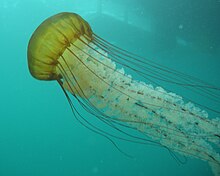| Chrysaora fuscescens | |
|---|---|

| |
| Scientific classification | |
| Domain: | Eukaryota |
| Kingdom: | Animalia |
| Phylum: | Cnidaria |
| Class: | Scyphozoa |
| Order: | Semaeostomeae |
| Family: | Pelagiidae |
| Genus: | Chrysaora |
| Species: | C. fuscescens
|
| Binomial name | |
| Chrysaora fuscescens Brandt, 1835
| |
| Synonyms | |
| |
Chrysaora fuscescens, the Pacific sea nettle or West Coast sea nettle, is a widespread planktonic scyphozoan cnidarian—or medusa, "jellyfish" or "jelly"—that lives in the northeastern Pacific Ocean, in temperate to cooler waters off of British Columbia and the West Coast of the United States, ranging south to México. The Pacific sea nettle earned its common name in-reference to its defensive, 'nettle'-like sting; much like the stinging nettle plant (Urtica dioica), the sea nettle's defensive sting is often irritating (possibly mildly painful) to humans, though rarely dangerous.
The Pacific sea nettle has a distinctive, golden-brown bell—the main functioning 'body' or 'head' of a jelly—with a reddish tint. The bell can grow to be larger than one meter (3’) in diameter in the wild; however, most are less than 50 cm across. The long and spiraling, whitish oral arms (and 24 undulating, maroon tentacles) may trail behind the nettle as far as 15 feet (4.6 m).
Since about the mid-20th century, C. fuscescens has proven to be a very popular cnidarian to feature at aquariums (and even some zoos with aquatic exhibits), mainly due to the public's fascination with their bright colors and extremely long tentacles. Additionally, the species is known for being quite low-maintenance in captivity, when provided with the appropriate water parameters and conditions. When these medusae are actively thriving under ideal conditions, they can even be easily bred via the culturing of polyps.[1]
- ^ "Chrysaora fuscescens". Jellieszone.com. Archived from the original on 2013-10-01. Retrieved 2013-10-08.